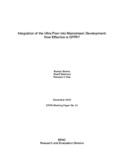Integration of the ultra poor into mainstream development: How effective is CFPR?
Abstract
The paper aims to understand the dynamics of participation of the Targeting the Ultra Poor (TUP) members of Challenging the Frontiers of Poverty Reduction (CFPR) phase I in the financial market since their graduation from the CFPR program. The analysis was done using the longitudinal panel data (2002, 2005 and 2008). It has been found that after two years of program support and the provision of some flexibilities in borrowing from BRAC microfinance, the ultra-poor can meaningfully participate in the formal credit markets. Their active participation can help them achieve long-term benefits in the form of increased per capita income. Participation in the program has brought about significant positive impacts in the rate of borrowing as well as lending and saving behaviours of the participant households. More than two-thirds of the sampled members had ended up participating at least once in BRAC microfinance. Those who had participated more than once tended to use the loans more for productive purposes like to run their small business enterprises than for consumption. Participation in BRAC microfinance has mostly been influenced by demographic profiles like marital status, level of awareness, the number of male working-aged members, and self-perceived economic status—before participation in the CFPR program and later after graduation whether they were in a separate Village Organization (VO) or in a VO merged with the general microfinance borrowers. Being in separate VOs was one of the strong determinants of BRAC microfinance participation.

